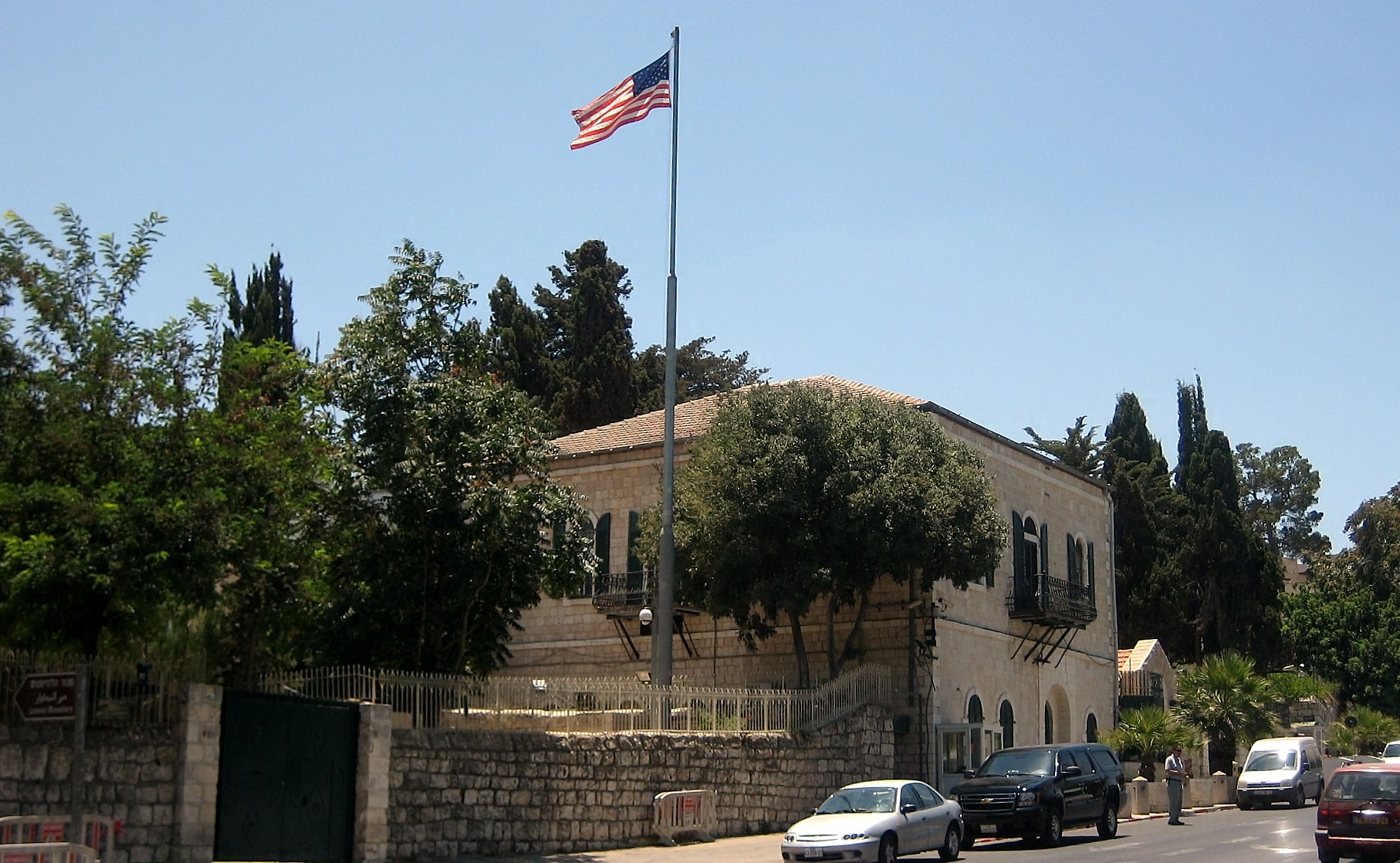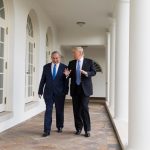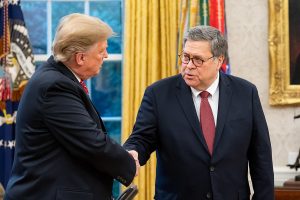by Zaha Hassan
During his meeting with the Israeli prime minister last week, President Trump told reporters that moving the US embassy from Tel Aviv to Jerusalem will only cost US taxpayers $250,000 rather than the billion-dollar price tag he claims was originally proposed. This “bargain” likely refers to the costs of temporarily housing the embassy at the current site of the offices of the US consulate in Jerusalem. Unloading a moving truck and replacing some signage is no groundbreaking. For a man who likes to boast about his real-estate deals and construction projects, converting the consulate to an embassy appears anti-Trumpian.
But the issue is not the cost; it’s about location, location, location. And that location is occupied territory.
Where the US establishes its embassy in Israel is an important statement about where the US sees borders being drawn between Israelis and Palestinians. It also foreshadows the coming “ultimate deal” that the Trump administration will soon unveil.
Trump’s Decision
Initially, the Trump administration played down the decision to move the US embassy, saying there would be no practical effect. US passports would continue to leave blank the country of birth for US citizens born in Jerusalem. The US was not taking a position on final status issues, including the specific boundaries of Israeli sovereignty in Jerusalem. President Trump said in his December speech, “[t]hose questions are up to the parties involved.”
But is the US taking a position now? Can the US still profess to be neutral in the Israel-Palestine conflict and have its embassy in territory occupied by Israel in 1967?
Today, the city of Jerusalem—East and West—is recognized internationally as a subject for final-status negotiations between Israelis and Palestinians. Under international law, no part of Jerusalem is legally part of Israel’s sovereign territory. In fact, when Israel announced that Jerusalem was its “undivided” capital in 1980—meaning that it claimed the territory of East Jerusalem it occupied in 1967 along with West Jerusalem—the international community swiftly condemned the action as a flagrant violation of international law. The few countries that had diplomatic missions in Jerusalem removed them pursuant to UN Security Council Resolution 478.
Had the president decided to relocate the US embassy to West Jerusalem and recognized East Jerusalem as the capital of the future state of Palestine, he might have been able to argue that he was acting consistent with US policy and international consensus around the two-state solution. Instead, President Trump has chosen to relocate the embassy to a site that confirms Palestinians’ worst fears and supports Israel’s maximalist designs over the entire city.
History of a Place
Before the creation of the state of Israel, the area were the US embassy will be relocated was public property belonging to the government of Mandatory Palestine. After the 1949 Armistice Agreement between Israel and Jordan, the area in question became a sort of buffer zone—a “No Man’s Land”—between Israeli and Jordanian troops. Israeli troops held West Jerusalem while Jordanian troops were in charge of East Jerusalem. Although each side had its interests in the No Man’s Land, neither controlled it.
In 1967, the Israeli military occupied the West Bank, including East Jerusalem and the No Man’s Land. UN Security Council Resolution 242, which forms the basis for the two-state solution and its “land for peace” framework, emphasized the inadmissibility of the acquisition of territory by war and affirmed that Israel must withdraw from territories it occupied during the conflict—and that included the No Man’s Land.
So why didn’t the Trump administration just find a location in West Jerusalem that might have allowed it to constructively deny that the embassy move was meant to recognize Israeli sovereignty over all of Jerusalem? The answer, unlike the 1949 Armistice line, isn’t as easy to pinpoint.
Trump’s Motives
Perhaps the U.S. president fully supports Israeli sovereignty over all Jerusalem and he wanted to take effective action to foreclose Palestinian claims to a capital in Jerusalem. Or perhaps it was all politics. The president may have made a calculation that bolstering his support among evangelicals and with pro-Israel donors like Sheldon Adelson was necessary in light of the way Robert Mueller’s investigation seems to be closing in on him and the head of his Mideast peace team, Jared Kushner. Locating the US embassy in East Jerusalem would support the idea of an “undivided Jerusalem,” which evangelicals and pro-Israel donors demand.
Or maybe Trump’s intentions were not meant to be prejudicial at all. After all, it’s difficult to come by vacant land suitable for a US embassy and its security requirements in West Jerusalem, and the site previously identified in the western part of the city is mired in its own legal controversy. Most of the property at the proposed West Jerusalem embassy site is privately owned by Palestinians—some of whom are US citizens—and the Muslim authority responsible for religious endowments, the Waqf. Building on a site illegally confiscated from its owners in order to build a US embassy would open up potential legal challenges in the US by the Palestinian-American owners. So, changing the signage of the US consulate offices in occupied Jerusalem may have been the path of least resistance for the Trump administration.
The president has indicated that he may attend the ribbon-cutting for the opening of the embassy in Jerusalem on May 14, a date meant to coincide with Israel’s seventieth anniversary but is also the anniversary of when the state of Israel forced 750,000 Muslim and Christian Palestinians from their homes and villages to create a Jewish majority in the new country. To add insult to injury, the opening is likely to coincide as well with the start of the Muslim holy month of Ramadan.
Though Trump may think he got the US embassy in Jerusalem for a steal, the price in terms of US credibility, Israel-Palestine peace, and regional stability couldn’t be higher.
Zaha Hassan is a Middle East Fellow at New America. She is a human rights lawyer and former coordinator and senior legal advisor to the Palestinian negotiating team during Palestine’s bid for UN membership (2010-2012). Photo: U.S. consulate in Jerusalem (Wikimedia Commons).






It’s odd that the author, in invoking the “inadmissibility” clause of UN Security Council Resolution 242, applies it only to one side in 1967, not to the other side in 1948. It applies just as equally to the Arab seizure of eastern Jerusalem and Judea & Samaria (as they were known before they became the so-called “West Bank” OF Trans/Jordan for 19 years).
If the territories are currently “occupied”, then what state is “occupied”?
Until Jordan rescinded its claims to these territories in 1988, it was frequently referenced as “occupied JORDAN”. But given the inadmissibility clause, it couldn’t have been given that Jordan acquired it by aggressive use of force.
Likewise it can’t be “Occupied ‘Palestine'”. No Arab Palestine came to be given the Arab parties violent rejection of the UN Partition compromise (UN General Assembly Resolution 181). Furthermore the Fourth Geneva Convention (Article 2) stipulates that only territories of High Contracting Parties (states) can be “occupied”.
Was it “Occupied Corpus Separatum” – the international zone established by UNGAR 181? Problem is that given the violent Arab rejection of 181, that never came to be (the first part of 181, terminating the Mandate, is authoritative, the General Assembly acting within its purview of trust territory administrator (under Chapter XII of the UN Charter). The 2nd part, the “plan of partition with economic union” required the agreement of the parties). So the answer is “no” on grounds that the Corpus Separatum didn’t exist and again only states can be “occupied”.
What UNSCR 242 does in fact say – and this is supported by the debate that led to its proclamation as well as the repeated explanations of the authors then and thereafter – is that the territories are not Israel’s by default simply based on its defensive conquest in 1967.
That is to say, UNSCR 242 established the “land for peace” formula (not “peace for land”). Rather than specify where the border should be, rather than require an immediate, unilateral, unconditional and full Israeli withdrawal, the Resolution envisions Israel withdrawal to negotiated lines based on (and after) peace is established.
It makes perfect sense. The ancient Jewish quarter of Jerusalem (in the Old City, in the eastern half) will clearly become part of Israel. Is it then “Israeli ‘occupied’ Israel” now? Maybe in return Israel cedes Um el Fahm (an Arab city just on the Israeli side of the 1949 Armistice Line). Does that mean the city was “occupied” by Israel all these years and no one knew it?
Alternatively, if one wishes to look backward rather than forward, the status quo ante (before 181) was the Palestine Mandate which entrusted (Articles 2, 4, 5, 6 and 25) all of western Palestine (then the Greek/Latin-European name for the Land of Israel, not a reference to an Arab country or ethnic group) to a Jewish state (“homeland” being used in deference to earlier the Balfour Declaration, but the point of Mandates was to establish states, not homelands/Bantusans, and there is no mechanism for such to exist within a larger state in the document, or for any other self-determined state).
Before permanent political borders are negotiated (as part of a peace agreement), the label “occupied” simply adds more heat than light (and it is generally meant to do so by its purveyors, as if anything one party does is somehow legitimized “because ‘occupation'”).
What needs to happen next is the parties sitting down and negotiating an agreement, including borders.
@LEERON It doesn’t make the least bit of difference that the Arabs rejected UN 181. That resolution does not carry the weight of law in any event, and it did not — in and of itself — “create Israel” (just as the Balfour Declaration didn’t either). Israel unilaterally and voluntarily declared the UN 181 lines to be its borders when it sought recognition of the new state from (first) the U.S. and (later) the U.N. It specifically declared those lines to be its borders, and they remain Israel’s borders to this very day. You can see the related correspondence (Weizmann, Epstein, Truman) on the Truman Library website. Read it yourself. Clark Clifford gives us the backstory behind this in his book “Counsel to the President” on p. 19.
In any event, Jerusalem was not even an issue until AFTER the occupation in 1967 and, up until then showed no particular interest in it. Doesn’t anyone even wonder why the earlier Zionists settled on the coast and claimed that for their new state (with Tel Aviv as their capital)? Walter Laquer, in the Preface to his book “A History of Zionism” sheds some light on this:
The question of Jerusalem illustrates best the enormous difference between historical Zionism and the ideology that has replaced it. Jerusalem contains the holy places of three world religions, and elementary prudence if not basic tolerance should have prevented declarations according to which Jerusalem was to remain forever undivided under Israeli rule. It was in any case an empty declaration, for in actual fact Jerusalem is of course a divided city. When Herzl first visited Jerusalem he saw only the musty deposits of two thousand years of inhumanity, intolerance, and impurity; he perceived superstition and fanaticism on all sides. It was not surprising that he suggested Haifa as the capital of the new Jewish state. But it was not only Herzl, the assimilated Jew, who reacted in this unsentimental manner. Chaim Weizmann always feared becoming involved in the Jerusalem imbroglio. And because their emotional attachment to the city was not overwhelming, David Ben Gurion and other leaders of the second aliya did not visit Jerusalem for the first time until two or three years after their arrival in the country. For many years not a single pre-state Zionist leader chose to live in Jerusalem. For them, Jerusalem symbolized the negative past of Jewish history, that part of the tradition from which they wanted to disassociate themselves. The idea that Jerusalem was the beginning and the end of Zionism, that Israel could not exist without having full sovereignty over the entire city, emerged only after 1967 and with the growth of a religious fanaticism and aggressive nationalism that had more in common with the ideology of the Muslim Brotherhood than the founding fathers of Zionism.
And so, guarding the holy sites has become a nightmare and Jerusalem itself has become a dangerous flashpoint. The insanity of a few religious fanatics—Jewish, Muslim, or Christian—has the potential for transforming a local conflict into a religious war with incalculable consequences.
Walter Laquer in the Preface to “A History of Zionism”, p. 13